Key takeaways:
- Sustainability in fashion encompasses mindful shopping practices that consider the environmental and social impacts of clothing production.
- Sustainable jeans significantly reduce the environmental footprint by utilizing organic materials, ethical production practices, and eco-friendly dyes.
- Challenges in sustainable shopping include discerning genuine brands, higher price points, and finding the right fit and style.
- Promoting sustainable choices involves effective communication, sharing personal shopping experiences, and building a community focused on eco-friendly practices.
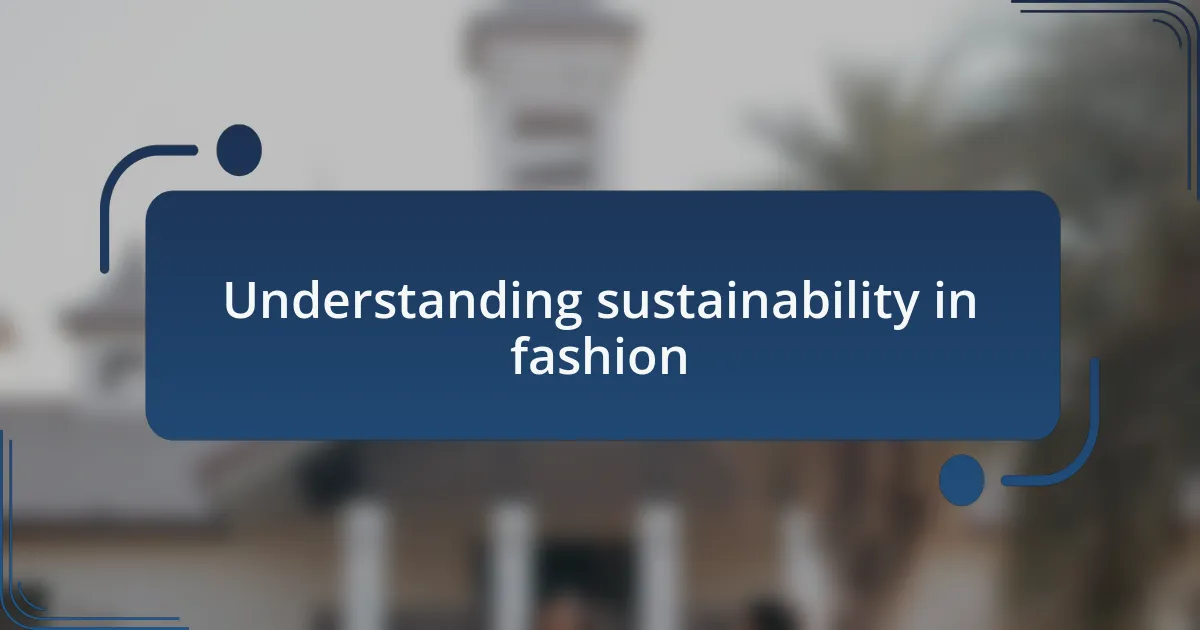
Understanding sustainability in fashion
Sustainability in fashion is more than a trendy buzzword; it reflects a profound shift in how we perceive our clothing’s impact on the planet. I often find myself pondering how many jeans I’ve owned that ended up in landfills, contributing to a cycle of waste. This realization has ignited my passion for understanding the materials and processes behind the clothes we wear.
When I discovered that conventional denim production can consume thousands of gallons of water and involve hazardous chemicals, it was a wake-up call. Have you ever considered the hidden cost of your favorite pair of jeans? I now actively seek brands that prioritize sustainable practices, ensuring my choices support a healthier environment.
Sustainable fashion is ultimately about mindfulness—the way we shop, the materials we choose, and the stories we support with our purchases. I remember feeling a sense of pride when I finally switched to a brand that not only produced ethically crafted jeans but also gave back to communities in need. It transformed my shopping experience into an opportunity to make a positive impact, reminding me that every purchase can be a step toward a more sustainable future.
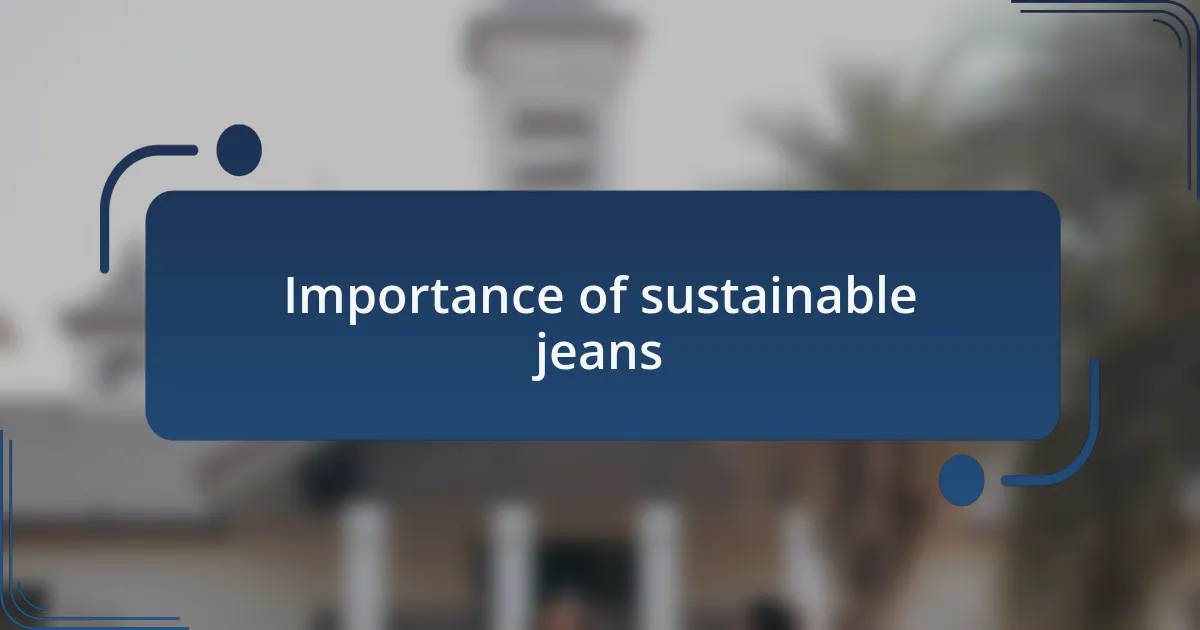
Importance of sustainable jeans
Sustainable jeans are essential for reducing the environmental footprint of fashion. I still remember the first time I learned about the staggering amount of water used in traditional denim production. It was a shock to realize that a single pair of jeans could use over 1,800 gallons of water from seed to finish. This awareness motivated me to seek out brands that prioritize water-conserving methods, such as using recycled water and innovative dye technologies.
Moreover, the social implications of sustainable jeans cannot be overlooked. After visiting a socially responsible brand’s factory, I was deeply moved by the fair working conditions and community-focused initiatives. It struck me that when I invest in sustainable jeans, I’m not just making a fashion choice; I’m contributing to the welfare of workers and their families around the globe. How can we turn a blind eye to that impact?
Choosing sustainable jeans often means embracing quality over quantity. I’ve discovered that these well-made pieces last longer and fit better, ultimately saving me money in the long run. Have you ever felt the difference between cheap jeans that fade after a few washes and a pair crafted from organic materials? The latter not only enhances my wardrobe but also aligns with my values, making each wear feel like a conscious decision toward a stylish and sustainable future.

Key features of sustainable jeans
Sustainable jeans often feature organic cotton or alternative materials, like Tencel or hemp, which drastically reduce chemical usage. I remember my excitement when I first slipped on a pair of jeans made from Tencel; they felt so soft and lightweight. It really made me think—how much healthier is this option for not just my wardrobe, but also for the planet?
Ethical production practices are another hallmark of sustainable jeans. Brands committed to sustainability often ensure fair wages and safe working conditions, which I’ve witnessed firsthand during tours of denim factories. It’s uplifting to know that my choice to buy a pair of sustainably made jeans not only benefits my closet but also supports a more equitable fashion industry. Isn’t it a powerful decision to feel that your money promotes positive change?
Lastly, sustainable jeans utilize eco-friendly dyes and water-efficient techniques that minimize waste. I recall reading about a brand that saved over 70% of water during the dyeing process; that blew my mind. This level of innovation pushes me to be more conscious about where I shop— aren’t we all responsible for promoting brands that care about our planet’s future?
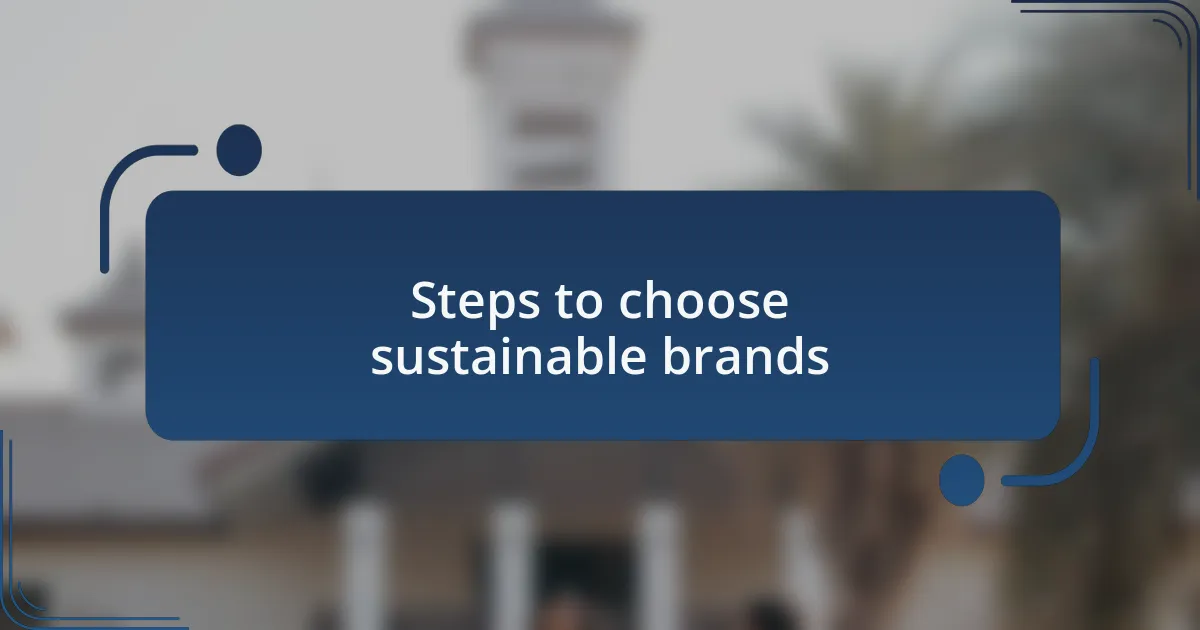
Steps to choose sustainable brands
When choosing sustainable brands, begin by examining their materials. I often read labels and research brands to find those that prioritize organic or recycled materials. Recently, I discovered a brand that uses recycled denim; it was a game-changer for me, knowing I was wearing something that contributed to reducing textile waste.
Next, investigate the brand’s production practices. Transparency is key. I’ve sometimes been surprised by the stories behind popular brands that fail to disclose their sourcing methods. A little digging can reveal whether a company pays fair wages and maintains ethical working conditions, which is so crucial for making informed choices.
Finally, consider the brand’s overall commitment to sustainability. I find it effective to look at their mission statements and their efforts toward reducing their carbon footprint. One brand I admire stands proudly behind a zero-waste policy, and I can’t help but feel a sense of pride knowing that my purchase supports a company that aligns with my values. How rewarding is it to wear something that reflects not only style but also my commitment to the planet?
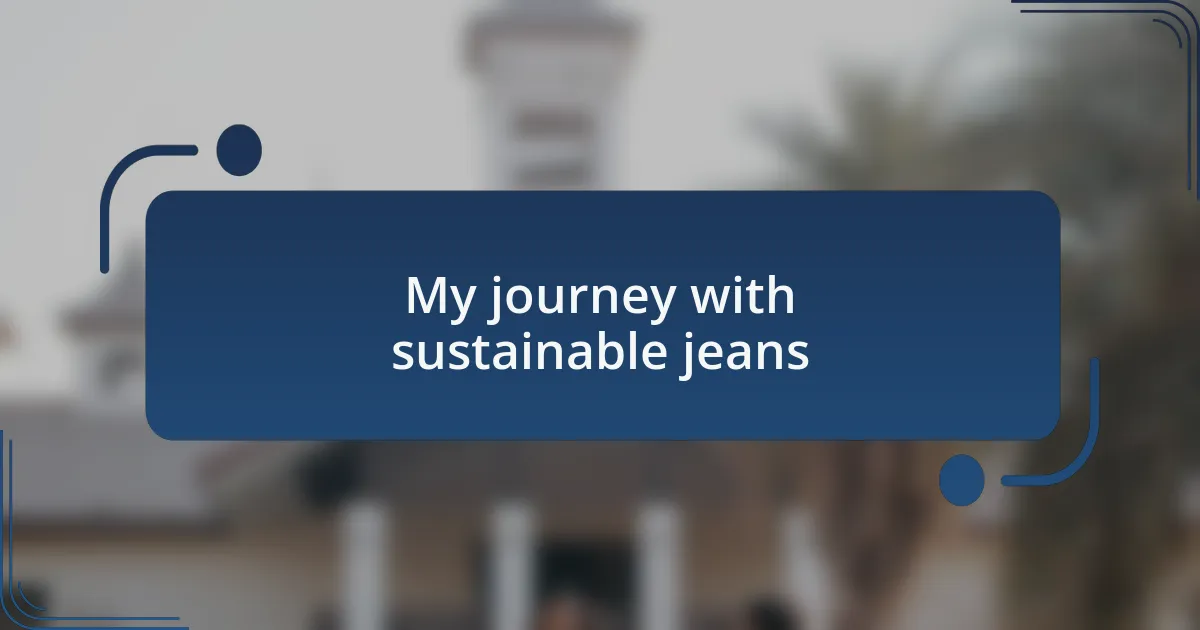
My journey with sustainable jeans
My journey with sustainable jeans began when I stumbled upon a local boutique offering a stunning pair crafted from organic cotton. As I tried them on, I felt a unique connection—not just to the fabric, but to the entire process behind it. It was a moment of realization that fashion could be both beautiful and responsible.
I remember browsing online and coming across a brand that caught my attention because of its innovative approach to sustainability. They used reclaimed materials in their designs, which sparked my curiosity. Suddenly, the idea of wearing jeans made from salvaged fabrics felt like a conversation starter, a way to share the importance of eco-conscious choices with my friends and family. Could something as everyday as jeans contribute to a larger environmental story?
As I continued to explore, I began to appreciate the passion that sustainable brands infused into their products. One memorable experience involved discovering a small company that involved local artisans in the production process. Supporting them wasn’t just about fashion; it felt like a meaningful investment in my community and the planet. Reflecting on these choices made me wonder—how often do we get to wear our values on our sleeves, or, in this case, our legs?
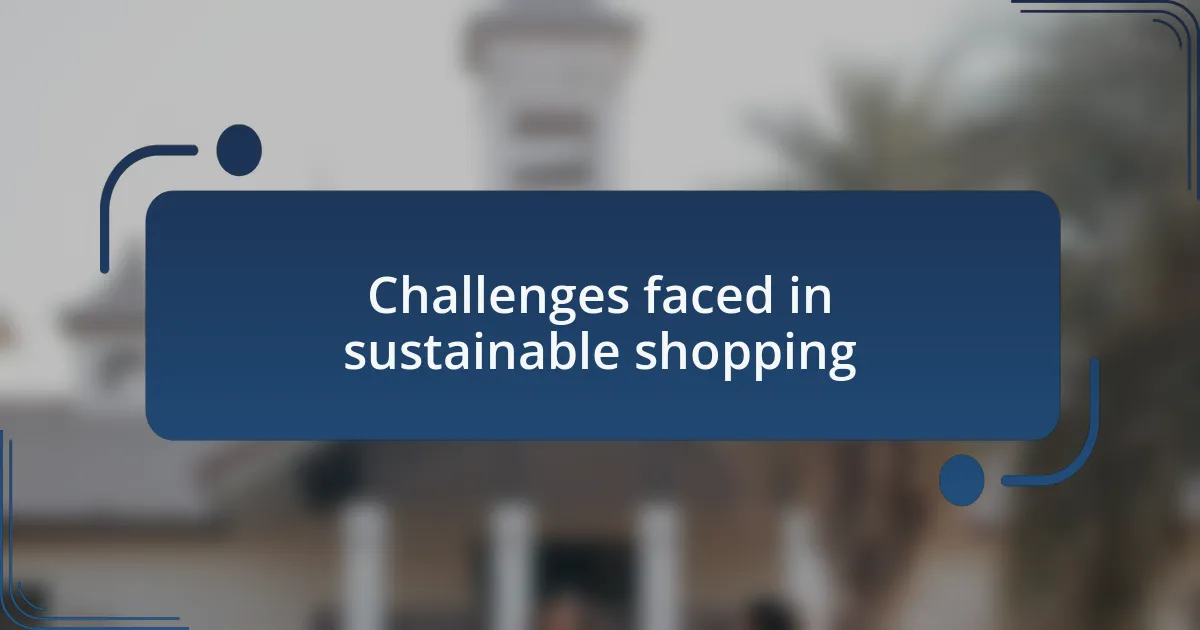
Challenges faced in sustainable shopping
One major challenge I encountered in my sustainable shopping journey was the overwhelming number of options. While there are many brands promoting eco-friendliness, it can be difficult to discern which ones are truly committed to sustainability. I often find myself questioning, “Are they genuinely ethical, or is it just a marketing tactic?” This uncertainty can lead to decision fatigue, leaving shoppers feeling lost amidst a sea of choices.
Another hurdle is the price point associated with sustainable jeans. I recall the first time I found a pair that fit all the criteria—ethical materials, fair labor practices—but the price was significantly higher than fast fashion alternatives. It made me wonder, “Why should my commitment to sustainability cost me more?” This dilemma often weighs heavily on my heart, as I aspire to support responsible brands while also being mindful of my budget.
Lastly, there’s the challenge of fit and style. I’ll never forget the excitement I felt when ordering a sustainable pair that looked amazing online, only to be disappointed when they arrived. It left me pondering, “How can we encourage sustainable practices without sacrificing style?” Finding the perfect intersection of fashion and ethics can be a journey in itself, often requiring patience and experimentation along the way.
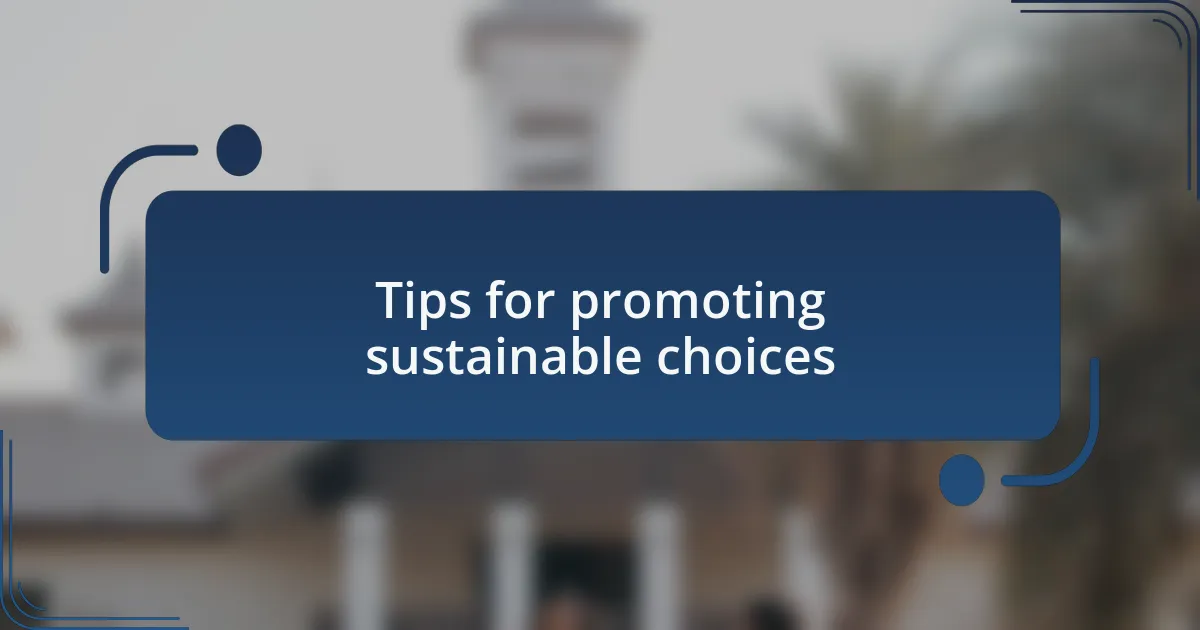
Tips for promoting sustainable choices
When it comes to promoting sustainable choices, I’ve learned that communication is key. I remember sharing my journey towards more eco-friendly options with friends and family, and it sparked engaging conversations. Have you ever tried explaining why sustainable choices matter? Often, when people understand the impact their choices can make on the planet, they become more invested in making changes themselves.
Another effective tip is to showcase real-life examples of sustainable shopping successes. For instance, I often share my experience of finding a brand that not only uses organic cotton but also supports local artisans. It’s through these personal stories that others can see the tangible benefits of shopping sustainably. Have you ever thought about the power your own stories could have? They can inspire others to walk the sustainable path alongside you.
Lastly, consider creating a community around sustainable shopping. I once joined a local event focused on sustainable fashion where we exchanged tips and ideas. It was not just enlightening, but it also felt great to connect with like-minded individuals. What if you organized or participated in such events? Building a network can further enhance commitment to sustainable choices, as we hold each other accountable while sharing our journeys.